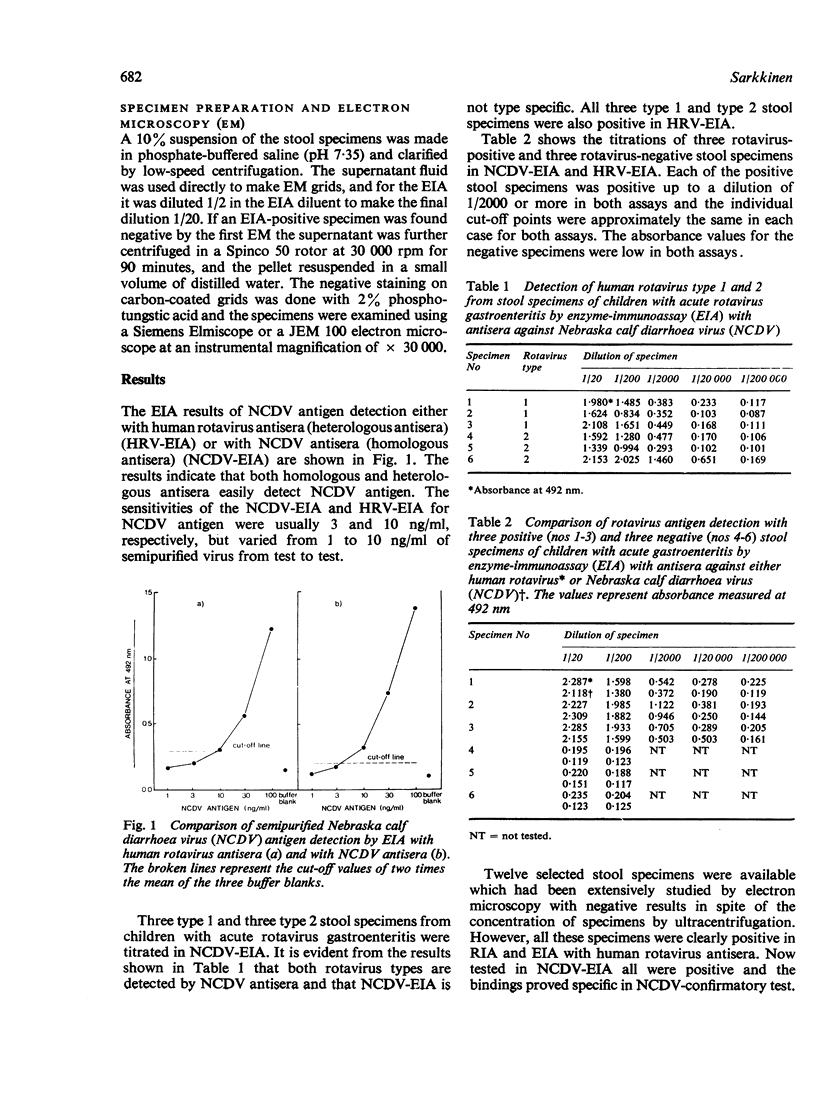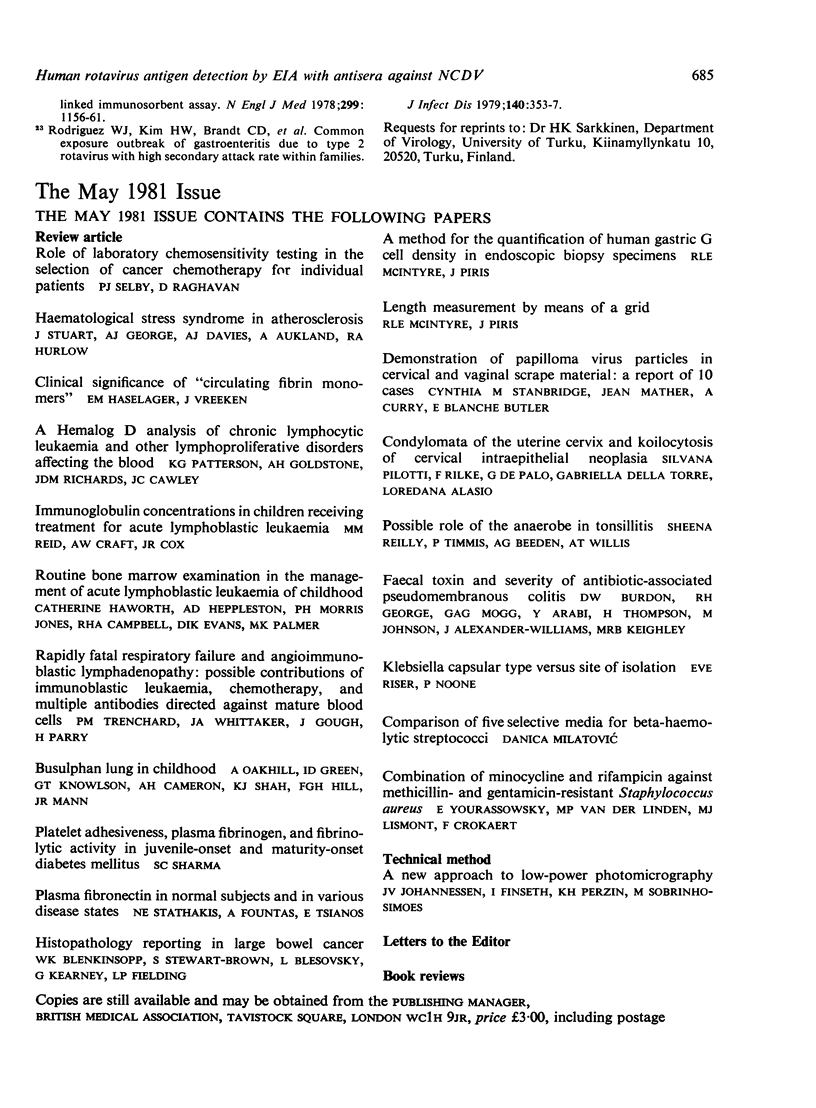Abstract
A four-layer solid phase enzyme-immunoassay (EIA) with antisera against Nebraska calf diarrhoea virus (NCDV) as immunoreagents was developed to detect human rotavirus antigens from stool specimens of patients with acute rotavirus gastroenteritis. Polystyrene beads were used as the solid phase, guinea-pig and rabbit anti-NCDV immunoglobulin as the catching and secondary antibody, and peroxidase-conjugated swine anti-rabbit immunoglobulin as the indicator antibody. A comparison of the developed NCDV-EIA with an identical EIA, using antisera against human rotavirus (HRV-EIA) instead of NCDV antisera, was made with 216 stool specimens positive or negative for rotavirus. A complete agreement was obtained between the two methods provided that appropriate confirmatory tests were included. The developed NCDV-EIA was as sensitive and specific for rotavirus as the HRV-EIA, and it allowed the detection of both established rotavirus types 1 and 2 from stools with equal sensitivity. The difficulties in cultivating human rotavirus in vitro for immunisation and the relative ease of growing NCDV in widely-used continuous cell lines make NCDV a good alternative in the preparation of the highly specific and sensitive rotavirus antisera required in immunoassays, and facilitate the setting-up methods for the routine diagnosis of rotavirus gastroenteritis by EIA or RIA in diagnostic virus laboratories.
Full text
PDF





Selected References
These references are in PubMed. This may not be the complete list of references from this article.
- Bishai F. R., Spence L., Goodwin D., Petro R. Use of antisera against bovine (NCDV) and simian (SA11) rotaviruses in ELISA to detect different types of human rotavirus. Can J Microbiol. 1979 Sep;25(9):1118–1124. doi: 10.1139/m79-174. [DOI] [PubMed] [Google Scholar]
- Bridger J. C. Location of type-specific antigens in calf rotaviruses. J Clin Microbiol. 1978 Dec;8(6):625–628. doi: 10.1128/jcm.8.6.625-628.1978. [DOI] [PMC free article] [PubMed] [Google Scholar]
- Bryden A. S., Davies H. A., Thouless M. E., Flewitt T. H. Diagnosis of rotavirus infection by cell culture. J Med Microbiol. 1977 Feb;10(1):121–125. doi: 10.1099/00222615-10-1-121. [DOI] [PubMed] [Google Scholar]
- Flewett T. H., Thouless M. E., Pilfold J. N., Bryden A. S., Candeias J. A. More serotypes of human rotavirus. Lancet. 1978 Sep 16;2(8090):632–632. doi: 10.1016/s0140-6736(78)92854-4. [DOI] [PubMed] [Google Scholar]
- Halonen P., Sarkkinen H., Arstila P., Hjertsson E., Torfason E. Four-layer radioimmunoassay for detection of adenovirus in stool. J Clin Microbiol. 1980 Jun;11(6):614–617. doi: 10.1128/jcm.11.6.614-617.1980. [DOI] [PMC free article] [PubMed] [Google Scholar]
- LOWRY O. H., ROSEBROUGH N. J., FARR A. L., RANDALL R. J. Protein measurement with the Folin phenol reagent. J Biol Chem. 1951 Nov;193(1):265–275. [PubMed] [Google Scholar]
- Mathan M., Almeida J. D., Cole J. An antigenic subunit present in rotavirus infected faeces. J Gen Virol. 1977 Feb;34(2):325–329. doi: 10.1099/0022-1317-34-2-325. [DOI] [PubMed] [Google Scholar]
- Middleton P. J., Holdaway M. D., Petric M., Szymanski M. T., Tam J. S. Solid-phase radioimmunoassay for the detection of rotavirus. Infect Immun. 1977 May;16(2):439–444. doi: 10.1128/iai.16.2.439-444.1977. [DOI] [PMC free article] [PubMed] [Google Scholar]
- Peterson M. W., Spendlove R. S., Smart R. A. Detection of neonatal calf diarrhea virus, infant reovirus-like diarrhea virus, and a coronavirus using the fluorescent virus precipitin test. J Clin Microbiol. 1976 Mar;3(3):376–377. doi: 10.1128/jcm.3.3.376-377.1976. [DOI] [PMC free article] [PubMed] [Google Scholar]
- Petric M., Szymanski M. T., Middleton P. J. Purification and preliminary characterization of infantile gastroenteritis virus (orbivirus group). Intervirology. 1975;5(3-4):233–238. doi: 10.1159/000149919. [DOI] [PubMed] [Google Scholar]
- Sarkkinen H. K., Halonen P. E., Arstila P. P. Comparison of four-layer radioimmunoassay and electron microscopy for detection of human rotavirus. J Med Virol. 1979;4(4):255–260. doi: 10.1002/jmv.1890040403. [DOI] [PubMed] [Google Scholar]
- Sarkkinen H. K., Meurman O. H., Halonen P. E. Solid-phase radioimmunoassay of IgA, IgG, and IgM antibodies to human rotavirus. J Med Virol. 1979;3(4):281–289. doi: 10.1002/jmv.1890030406. [DOI] [PubMed] [Google Scholar]
- Spence L., Fauvel M., Bouchard S., Babiuk L., Saunders Letter: Test for reovirus-like agent. Lancet. 1975 Aug 16;2(7929):322–322. doi: 10.1016/s0140-6736(75)92752-x. [DOI] [PMC free article] [PubMed] [Google Scholar]
- Thouless M. E., Bryden A. S., Flewett T. H. Serotypes of human rotavirus. Lancet. 1978 Jan 7;1(8054):39–39. doi: 10.1016/s0140-6736(78)90381-1. [DOI] [PubMed] [Google Scholar]
- Tufvesson B., Johnsson T. Immunoelectroosmophoresis for detection of reo-like virus: methodology and comparison with electron microscopy. Acta Pathol Microbiol Scand B. 1976 Aug;84(4):225–228. doi: 10.1111/j.1699-0463.1976.tb01929.x. [DOI] [PubMed] [Google Scholar]
- Yolken R. H., Kim H. W., Clem T., Wyatt R. G., Kalica A. R., Chanock R. M., Kapikian A. Z. Enzyme-linked immunosorbent assay (ELISA) for detection of human reovirus-like agent of infantile gastroenteritis. Lancet. 1977 Aug 6;2(8032):263–267. doi: 10.1016/s0140-6736(77)90951-5. [DOI] [PubMed] [Google Scholar]
- Zissis G., Lambert J. P. Different serotypes of human rotaviruses. Lancet. 1978 Jan 7;1(8054):38–39. doi: 10.1016/s0140-6736(78)90380-x. [DOI] [PubMed] [Google Scholar]
- Zissis G., Lambert J. P. Enzyme-linked immunosorbent assays adapted for serotyping of human rotavirus strains. J Clin Microbiol. 1980 Jan;11(1):1–5. doi: 10.1128/jcm.11.1.1-5.1980. [DOI] [PMC free article] [PubMed] [Google Scholar]


